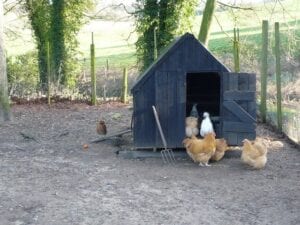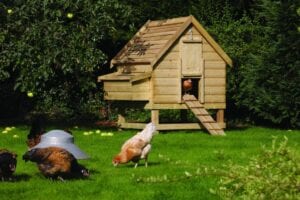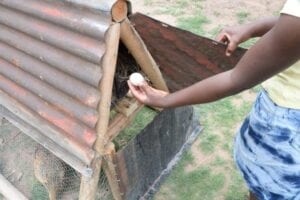Day 25: Backyard Poultry Part I: Feeding And Housing
Dear Student,
Few aspects of your self-sufficient endeavor will be as productive and enjoyable as a small backyard poultry flock. Remarkably self-reliant, poultry allowed to forage produce healthier meat and eggs and live a happier, healthier existence.
 Aside from consuming kitchen and garden wastes, they reduce pests, provide manure, provide scratching and weeding services, and provide nutritious eggs and meat. Poultry (like all elements in a good permaculture system) can recycle nutrients through your mini farm, upcycling available nutrients into more valuable forms.
Aside from consuming kitchen and garden wastes, they reduce pests, provide manure, provide scratching and weeding services, and provide nutritious eggs and meat. Poultry (like all elements in a good permaculture system) can recycle nutrients through your mini farm, upcycling available nutrients into more valuable forms.
Poultry require regular attention but are not difficult to manage. Birds can be quite entertaining in their antics, and noise isn’t really an issue… unless you choose to get a rooster and he is housed within earshot.
Ducks, geese, turkeys, guinea fowl are all popular options, but chickens are by far the most numerous domesticated animals in the world.
Feeding Chickens
As omnivores, chickens’ (and any other domestic fowl’s) basic needs are similar to our own. Plus, they are partially self-sufficient, able to forage for much their nutrition if given enough pasture.
A fast-growing meat bird or laying hen can forage for a quarter of its caloric requirements and possibly all its protein needs if given enough access to good pasture. The only contribution you’ll need to make on top of that is a cheap carbohydrate supplement, which can usually be supplied by on-farm waste products. If you’re short on grain waste at a particular time of year, crushed corn works nicely and costs very little.
Local or heritage breeds can be much better at foraging for themselves (meaning less feed costs), but these can take longer to grow (for meat) or produce less eggs (if you’re raising layers). It’s a trade-off worth considering based on your goals.
For optimal production, I recommend a free offering (all they want to eat) of kitchen scraps (no chicken parts) supplemented by farm-produced black soldier fly larvae (or worms in colder northern climates) and a cheap carbohydrate mix (crushed corn or other). These last two will be covered on Day 31 in our lesson on insects.
For good egg production, a calcium supplement is recommended, which can be made by simply baking egg shells and crushing them into your feed.
During the summer you can grow patches of chicken grain forages like buckwheat or barley, and kale or wild pea plants. These will significantly improve the amount of self-foraging the chicken can do for themselves, boosting their health and happiness.
During the winter in cold climates, you will need to provide some protein supplement for the birds, easily purchased at the feed store or generated on your mini farm with a little effort.
For convenience or for when all your on-site feed needs cannot be met from your own production, backup feeds are available from feed suppliers (providing full, organic nutrition).
If you purchase feed, be sure to only use non-medicated varieties. Medicated feed is used for factory poultry production in confinement and is necessary for the birds to survive the filthy and inhumane manner in which they are kept. Overexposure to subtherapeutic antibiotics and growth stimulants like this are one of the leading causes of many health issues in the Western world today.
Housing Chickens

Correctly designing and locating your fowl housing is important. Siting the housing close to on-farm food sources like vegetable gardens, for example, saves time and effort. Housing can be easily constructed from inexpensive or reclaimed materials and can be managed by just about anyone with basic skills and tools.
Chicken housing can be an endeavor all its own, and some folks get really into it, making little chicken palaces for their own amusement. It all works just the same from the chickens’ point of view… but you might prefer looking at something a little more ambitious if you have to see it every day.
There are thousands of designs for chicken coops online, and I’ve given a few of my favorite examples at the end of this lesson.
In essence, though, all coops must provide the same basic requirements:
- Shelter from the elements and to protect against predators at night.
- Perches to sleep on (at least 2 square inches in diameter, 8 inches of length per bird).
- Clean nest boxes to lay eggs if you wish to breed your poultry or use them for egg production (one square-foot box for every three hens). These nest boxes should have a roof to give the hens a sense of security, along with a clean bedding of straw, shredded paper, or cardboard to make it comfortable (change when soiled).
- Access to nutritious food and clean water.
- Access to fresh forage. I recommend pasturing or free-ranging, but forage can be carried into coops if free-ranging isn’t possible.

Coops can be sized to allow you to walk into them for easy access to interior spaces, or built smaller to save construction time and money. Smaller coops should have access hatches on the outer wall so you can reach the nest boxes from outside (to allow the easy removal of soiled bedding and to collect eggs).
To size according to your flock, make sure you provide:
- 3 square feet of floor space in the coop and 8 inches of perch space per bird.
- One 1-square-foot nest box per every two or three birds.
- Space for all birds to fit at feeders and waterers (fighting might occur if you don’t allow enough space for them all).
There are two main categories of housing, each with two subcategories…
